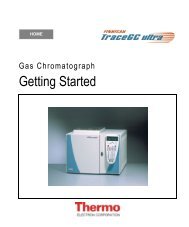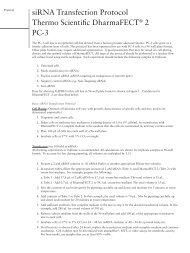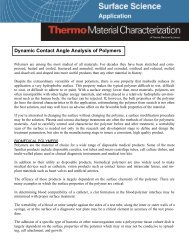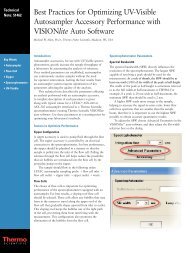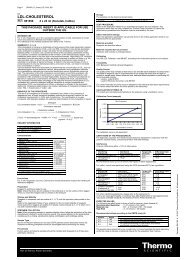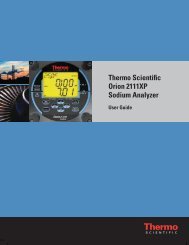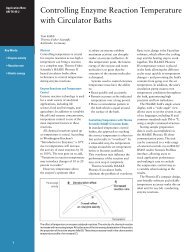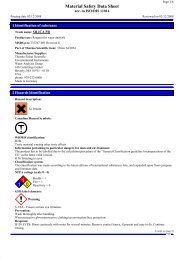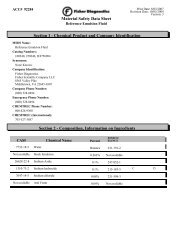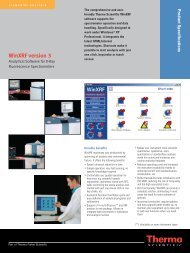2110XP Ammonia Analyzer User Guide (1574 Kb) - Thermo Scientific
2110XP Ammonia Analyzer User Guide (1574 Kb) - Thermo Scientific
2110XP Ammonia Analyzer User Guide (1574 Kb) - Thermo Scientific
Create successful ePaper yourself
Turn your PDF publications into a flip-book with our unique Google optimized e-Paper software.
General Information<br />
The sensing electrode responds logarithmically to changes in the ammonia<br />
ion concentration. This response is described by the Nernst equation:<br />
Where:<br />
E = E o + 2.3 (RT/nF) log (C/C iso )<br />
E = measured electrode potential, mV<br />
E o = potential, when C equals C iso , mV<br />
R = ideal gas constant<br />
T = temperature of sample, degrees K<br />
n<br />
F<br />
= valence of ionic species (+1 for ammonia ion)<br />
= Faraday’s constant<br />
C = effective ammonia ion concentration (activity)<br />
C iso = concentration (activity) of ammonia ion where potential E is<br />
temperature independent (isopotential point)<br />
The above equation indicates that the measured potential varies with both<br />
temperature and the concentration of the ion of the interest. In order to<br />
eliminate error caused by fluctuations in sample temperature, the <strong>2110XP</strong><br />
microprocessor constantly updates temperature corrections from data<br />
supplied by the ATC probe.<br />
From the Nernst equation, the theoretical response of a ammonia ion<br />
selective electrode to a ten-fold change in concentration at 25 ˚C is<br />
-59.16 mV. This is referred to as the electrode slope (S). Most electrodes,<br />
however, do not exhibit a theoretical slope. Therefore, the instrument is<br />
calibrated to determine its actual value. Two standards are used to provide<br />
information necessary for the microprocessor to compute the actual slope<br />
and E 0 for use during sample analysis.<br />
In order to eliminate interference from hydrogen ions, which can become<br />
significant when measuring low levels of ammonia, the <strong>2110XP</strong> adjusts the<br />
sample pH. This pH adjustment is accomplished by the patented passivediffusion<br />
process wherein the sample passes through a length of tubing<br />
contained in the reagent bottle. The reagent diffuses through the tube wall<br />
and mixes with the sample, which adjusts the sample pH to below 4.<br />
<strong>Thermo</strong> <strong>Scientific</strong> Orion <strong>2110XP</strong> <strong>Ammonia</strong> Monitor <strong>User</strong> <strong>Guide</strong><br />
I-4



